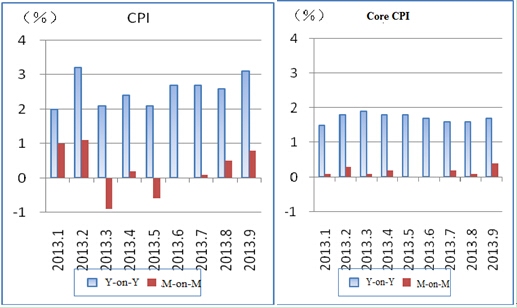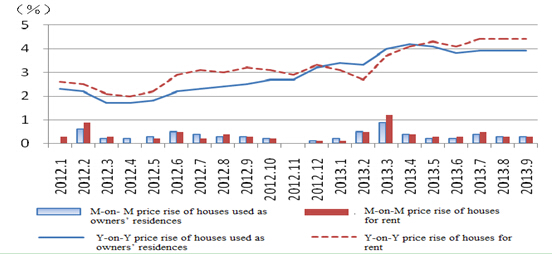Analysis of Price Performance in the Four Quarters of 2013 and Policy Options
Aug 18,2015
CPI growth remained relatively mild during the first three quarters of 2013, up by 2.5%, year on year; PPI decrease dwindled, down by 2.1% from a year earlier. It is predicted that demand will pick up slightly in the fourth quarter and the monetary liquidity will be neutral and slightly relaxed to prevent prices from rebounding continuously and drastically. However, the rigid rise of factor cost and the vibration of the prices of international bulk commodities at a high level and by a wide margin will produce some impact on price rise. At the same time, the seasonal fluctuations of food prices will tighten the pressure of short-term CPI rise. It is predicted that the CPI trends will remain stable on the whole during the entire year and CPI will go up by 2.7% or so, year on year; PPI decrease will continue to narrow by about -1.8% from a year earlier.
I. Main Features of the Price Trends in the First Three Quarters and the Analysis of Causes
With the roles played by an array of policies aimed at "maintaining growth, facilitating reform and adjusting structure", China's economic growth gradually stabilized in the first three quarters, showing a momentum of going up at a low level and taking a turn for the better from stability. CPI grew by a relatively mild margin, up by 2.5%, year on year, while PPI decreased on a tiny scale, down by 2.1% from a year ago.
1. CPI moved up slowly after its fall from an upward rush and the core CPI remained stable in the main
In the first two months of this year, CPI growth inched up from 2% to 3.2%, reaching a record high since May 2012. After March, CPI moved up gradually in fluctuations as compared with the same period of the previous year, to 3.1% in September. At the same time, after maintaining a month-on-month increase of over 1% for two months in the beginning of the year, CPI fell down and then went up. Particularly since July, the month-on-month growth strengthened evidently, to 0.8% in September.
In the first three quarters, the core CPI, after allowing for food and energy price rise, went up by 1.7%, year on year, and the year-on-year CPI growth in each month remained stable on the whole. The minimum growth, among others, appeared in January by 1.5%, while the highest was 1.9% in March. In addition, the month-on-month growth in each month did not fluctuate drastically (Figure 1).

Figure 1 Changes of CPI and Core CPI from January to September 2013
Source: National Bureau of Statistics, CEIC database.
2. Vegetable and meat price rise and fall induced CPI fluctuations and some service prices went up considerably
From January to September, food prices increased by 4.4%, year on year, and prices of industrial consumer goods and of service items increased by 0.8% and 2.8% from a year earlier. Among the 2.5 percentage points of CPI growth in the first three quarters, 1.44 points or so were fuelled by food price rise, making up 57.6% of CPI growth, playing the most prominent role in driving up CPI.
As regards food commodities, the ups and downs of vegetable and meat prices led to the short-term CPI fluctuations. With the short-term vegetable supply and demand being affected by such factors as unusual weather, natural disaster and holidays, the prices of fresh vegetables, among others, increased from 10% to -10.3% on year-on-year basis in February and March, dragging CPI from 0.34 positive percentage points down to 0.37 negative points; after June, vegetable prices grew in a fluctuating way, year on year, to 18.9% in September, driving up CPI by 0.55 percentage points. In addition, as breeding scale of cattle and sheep has been constrained in China by resource conditions in recent years, and because of the longer breeding period, higher cost and weak consumption substitution effect, the market supply and demand has been tight since this year and beef and mutton prices have gone up notably. At the same time, intervened by frozen meat purchase and storage continually conducted by the state, the pig grain ratio rose again above the break-even point, facilitating the rebounding of pork prices from negative to positive in June as compared to the same period of the previous year. Affected by it, the fluctuations in rise of prices of meat, poultry and related manufactured products in the first three quarters also brought an upward pressure to CPI growth to a certain extent. In September, the rise of prices of meat, poultry and related products alone drove up CPI by 0.49 percentage points, making up 15.8% of CPI growth in the same month (Table 1).
Table 1 Contribution of Y-on-Y Rise of Prices of Fresh Vegetable, Meat, Poultry and Related Products and Pork to CPI from January to September 2013
|
|
CPI on Y-on-Y basis (%) |
Fresh Vegetable |
Meat, Poultry and Related Products |
Pork | |||
|
Y-on-Y Comparison (%) |
Contribution (percentage point) |
Y-on-Y Comparison (%) |
Contribution (percentage point) |
Y-on-Y Comparison (%) |
Contribution (percentage point) | ||
|
January |
2.0 |
2.6 |
0.09 |
1.4 |
0.11 |
-5.0 |
-0.18 |
|
February |
3.2 |
10.0 |
0.34 |
5.3 |
0.40 |
-1.0 |
-0.04 |
|
March |
2.1 |
-10.3 |
-0.37 |
2.9 |
0.22 |
-5.5 |
-0.18 |
|
April |
2.4 |
5.9 |
0.20 |
1.5 |
0.11 |
-6.5 |
-0.21 |
|
May |
2.1 |
-1.9 |
-0.06 |
1.6 |
0.12 |
-4.9 |
-0.15 |
|
June |
2.7 |
9.7 |
0.26 |
4.8 |
0.34 |
1.1 |
0.03 |
|
July |
2.7 |
11.8 |
0.32 |
5.9 |
0.42 |
3.0 |
0.09 |
|
August |
2.6 |
5.2 |
0.16 |
7.2 |
0.52 |
6.0 |
0.18 |
|
September |
3.1 |
18.9 |
0.55 |
6.6 |
0.49 |
5.9 |
0.18 |
Source: National Bureau of Statistics.
Although service prices hold a lower weight than prices of food and industrial consumer goods, they played some role in driving up CPI. In the first three quarters, the growth of service prices tended to be stabilized as compared to the same period of the previous year, yet the growth was 0.9 percentage points higher than the same period of the previous year. Among various service items, some labor-intensive service prices grew by a wider margin; the year-on-year rise of prices of houses used as owners' residences and of houses for rent performed continuously on a higher level, and the month-on-month price rise in each month also remained positive (Figure 2).

Figure 2 Changes in CPI Rise of Self-Ownership Houses and of Houses for Rent from January 2012 to September 2013 CPI
Source: National Bureau of Statistics, CEIC database
The main reasons for the drastic increase of above-mentioned service prices include: First, the labor shortage during holidays and the complete release of the purchasing power aggravated the short supply of some service consumptions. Second, apart from the expanded house-rent demand from among migrant people flocking into big cities, factors like the evidently insufficient housing supplies in some cities, the policy relaxation and the alleviation of house purchasers' wait-and-see sentiment all helped to fuel the continuous price rise. Third, the trend-led labor cost rise constituted a long-term pressure to price rise.
…
If you need the full text, please leave a message on the website.














